Pros
Cons
Introduction
Product Tour
Front
Back
Sides
Bottom
Top
This model is the rather fetching Ruby Red, but the S630 also comes in Jet Black, Titanium Silver, Midnight Blue, and Royal Purple.
**Size Comparisons **
**In the Box **

- *
• Nikon Coolpix S630 camera
• Li-ion rechargeable battery EN-EL12
• Battery Charger MH-65
• USB Cable UC-E6
• Audio/Video Cable EG-CP14
• Strap AN-CP19
• Software Suite for COOLPIX CD-ROM
• Manual
• Quick Start Guide
Color
**Color Accuracy ***(14.23) *
The Nikon S630 captures color very accurately in its default color mode. Our color accuracy test is based on photographing the X-Rite ColorChecker chart under 3000 lux illumination, then using Imatest software to determine how far from the known values of the chart the test photos deviate. Click here for more on how we test color
The S630 did very well for most colors, especially light greens, blues and skin tones. The only areas it had any trouble were dark blues and cyans.
NOTE: Because of the way computer monitors reproduce colors, the images above do not exactly match the originals found on the chart or in the captured images. The chart should be used to judge the relative color shift, not the absolute captured colors.
Compared to the other cameras, the Nikon was a bit less accurate than the Sony T900, but better than the Canon SD780 IS and the Panasonic FX580.
Color Modes*(3.00)*
The S630 only has two color modes, Standard and Vivid, of which the first is far more accurate. Vivid mode oversaturates the image considerably, and strongly brightens blues, reds and oranges.**
**
Noise
Noise*(14.87)*
The Nikon S630 has very good noise levels, especially at higher ISOs. Image noise is the speckling that occurs across an image, especially at high ISO. Many point-and-shoot cameras use automatic noise reduction software to reduce this, which in turn can lead to images looking smeared. We test noise by shooting our ColorChecker chart at every full resolution ISO, under two different light levels (60 and 3000 lux), and use Imatest to measure the amount of noise in the image. Click here for more on how we test noise.
There are two interesting features in the chart above. First, noise levels are substantially worse under low light conditions at low ISOs. Second, the noise reduction software obviously kicks in at ISO 400, which is why the graph dips at that level.
You can see that compared to other cameras, the S630 remains consistently lower than just about every other camera in our comparison group.
The S630's consistently low image noise gives it a significantly higher score than the other tested cameras.
ISO*(8.50)*
At full resolution, the S630 has a good range of ISOs, from 64-1600. The camera can be bumped up to 3200 or 6400, but the resolution is reduced down to three megapixels at these extended-range settings. In addition to the usual auto ISO mode, there are two fixed-range auto ISO settings, one for ISO 64-200, one for ISO 64-400.
NOTE: The images above are not used in our testing or scoring, but are included here to show real-world examples of the differences between cameras at the various ISO settings. The color differences are due to each camera's automatic white balance dealing with the light sources slightly differently.
Resolution
Resolution*(12.35)*
The Nikon S630 scored well in our resolution testing, which is divided into three sections: sharpness, chromatic aberration and distortion. The S630 performed exceedingly well in distortion, and decently in chromatic aberration and sharpness. We run these tests by shooting a resolution chart at three focal lengths, and analyzing the distortion, sharpness and chromatic aberration using Imatest software. Click here for more on how we test resolution.
Distortion (16.01)
Distortion was exceptionally low at every focal length. At 46.2mm and 15mm, it was less than 0.1% of pincushioning. At 6.6mm there was slightly below 0.2% of barrel distortion. These are much lower than most other cameras, and means that you will suffer almost no warped lines around the edges of your images.
Sharpness (12.08)
Image sharpness is a bit below average. It was highest at the center of the lens, which then dropped off around the middle area, before picking up again at the edges. The 6.6m focal length produced both the sharpest results, at the very center of the lens, and the worst sharpness, at that dead zone half-way between the center and outer corners.
Chromatic Aberration (7.52)
Overall, chromatic aberration wasn't a major problem. At 15mm, the chromatic aberration showed a similar trend to the sharpness, where it was best at the center, got worse going outwards, and then improved a bit at the extremities. At 6.2mm and 46.2mm, the color fringing was its best at the center, then worsened the farther out from the center we measured.
Thanks to the excellent distortion performance, and decent sharpness and chromatic aberration results, the S630 scored well in our resolution testing.
Picture Quality & Size Options*(7.75)*
While the Coolpix S630 has a good range of size options, only at the largest resolution (12-megapixels) are you given any choice for compression (high or normal). There is no option to shoot RAW files.
Image Stabilization*(0.00)*
Our stabilization test is performed using a computer-controlled rig to consistently shake at the same rate. We shoot under 100 lux illumination and shutter speeds close to 1/30th of a second, the sort of conditions where image stabilization would really help. However, the vibration reduction system in the Nikon Coolpix S630 produced no improvement in image resolution under these settings. Click here for more on how we test image stabilization.
Video
Movie Mode*(8.75)*
The Coolpix S630 movie mode is a bit of a disappointment. In a market where more and more cameras are recording HD video, the S630 feels distinctly anachronistic in its 640x480 or 320x240 video options.
Also disappointing is the lack of control offered in Movie Mode. There's no white balance, ISO, metering, color options or autofocus area controls. You can chose video resolution, continuous or single autofocus, vibration reduction or macro mode. This is a decidedly limited control set. The optical zoom is also turned off while recording, but you can digitally zoom (and lose image quality in the process).
Video Color*(2.86)*
In movie mode, the S630 removes any white balance control, leaving it stuck on automatic. The Nikon really struggled with the incandescent bulbs we test under, which accounts for the large color error, significantly higher than the other cameras in our comparison group. Click here for more on how we test video color.
Video Sharpness*(0.71)*
Due to the standard-def nature of the S630, it really struggled in our sharpness test compared to cameras with more up-to-date video modes. Both vertically and horizontally, the sharpness was decidedly low. Click here for more on how we test video sharpness.
The S630 can record at 640x480 or 320x240, at either 30fps or 15fps, in motion JPEG format. The maximum length of a movie file is 25 minutes.
Sample Photos
Sample Photos
Click on any of the following image samples to see them at full size. If you're on a slow connection, this may take some time to load, as they're very large files.
Still Life Examples
Click on any of the images below to be taken to a full size version. These may take some time to load, as they are on the large side.
NOTE: The images above are not used in our testing or scoring, but are included here to show real-world examples of the differences between cameras at the various ISO settings.
Playback
Playback Mode*(10.50)*
The S630 playback mode diverges somewhat from what you see in most point-and-shoot cameras. It lacks the ability to alter the amount of information displayed on the screen at the time, so you can't see EXIF data, or histograms. What it gains, on the other hand, is a number of sorting tools and different ways of grouping the images.
If you zoom out from a full-screen photo, you'll be taken through three levels of thumbnail image displays, and then a Calender View. While in playback, the images can be sorted by Favorite Pictures, Auto or List By Date, all of which are accessed by pressing the Play button again. List By Date is different from Calendar View, in that the former only lists the dates on which photos were recorded, and the latter shows a calendar of the month, with the days photos were taken highlighted.
Auto Sort divides photos into Smile, Portraits, Food, Landscape, Dusk to Dawn, Close-ups, Movies, Retouched Copies and Other Scenes, depending on the shooting mode used to take the picture.
Favorite Pictures is a set of nine albums, each of which can hold up to 200 images. These folders can be customized with one of 10 icons, and set to one of six colors. Photos are added to these albums by pressing the OK button during playback.
In-Camera Editing*(5.00)*
The S630 has a pretty good selection of editing tools tucked into its system. Quick retouch tweaks contrast and saturation at high, medium or low levels. D-lighting boosts dynamic range to maintain detail in brightly lit and dark areas. You can also rotate the image, trim while zoomed in playback, or resize down to 640x480, 320x240 or 160x120.
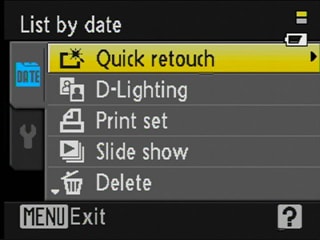
Editing controls
If you edit an image, the edited version is always saved separately, keeping you from destroying a precious original file.
Direct Print Options*(4.00)*
The DPOF and PictBridge controls on the S630 are good, if not amazing. You can select the number of files to print, specify paper size, and imprint shooting information and/or date and time the photo was taken. The only feature noticeably lacking is the ability to print proof sheets.
Hardware
Viewfinder*(0.00)*
The Nikon Coolpix S630 does not have a viewfinder.
LCD*(4.40)*
The LCD measures 2.7 inches diagonally, with 230,000-dot resolution. Brightness can be adjusted to one of five levels of brightness. Not a screen that will blow your socks off, but it serves the purpose well enough.
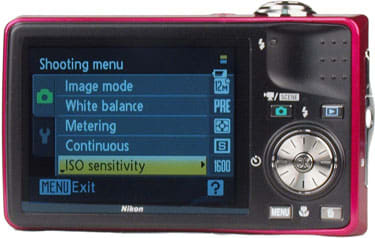
230,000-dots isn't exactly groundbreaking
Flash*(6.00)*
The flash is placed a good distance from the lens, though it is rather easy to block it with a stray finger. Likewise the autofocus assist lamp, which is tucked in the upper right corner, is very easy to block. The flash can be set to auto, red-eye reduction, off, on, and slow-sync.

The flash and AF lamp are both easily blocked
The flash is fairly bright, with minimal light dropoff towards the edges. It's not very fast to recharge, though, and it doesn't work with burst mode. The autofocus assist lamp is especially anemic, and the camera really struggles to focus in low light.
Lens*(6.00)*
The lens on the S630 has a 7x zoom lens, from 6.6-46.2mm (equivalent to a 37-260mm in 35mm photography). While this is very limited in terms of wide-angle, it's a heck of a zoom in a small body. The maximum focal length is greater than some 10x zoom lenses out there (such as the Samsung HZ15W).
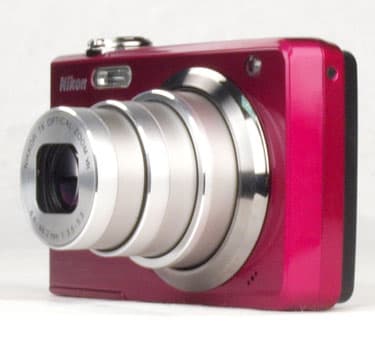
Fully extended lens
At wide angle the maximum aperture is f/3.5, and at full zoom it's f/5.3, which is about average.
Battery*(6.00)*
The S630 uses a Lithium ion rechargeable 3.7V battery. Nikon gives the battery life as approximately 220 shots per charge, which in our testing felt about accurate. This is on the low-end of average performance.
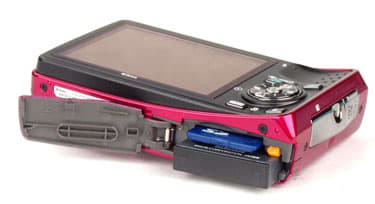
Battery and memory card
Memory*(3.00)*
The S630 takes SD and SDHC cards. They're inexpensive, easy to come by, and available in high capacities.
Jacks, Ports & Plugs*(2.00)*
The Nikon S630 has a single proprietary I/O port, used for both USB and AV connections.
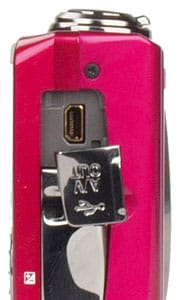
The sole I/O port
Controls
Shooting Modes*(10.00)*
The shooting modes on the Coolpix S630 are mostly run-of-the-mill, though they are arranged oddly. The Mode menu is divided into four tabs: Auto, which gives you the most amount of control; Scene, with 17 scene modes; Other modes, which has sport continuous, high ISO and smile detection; and finally Movie mode. What's missing are the manual exposure control, aperture-priority and shutter-priority modes that more advanced photographers look for, even in a compact camera.
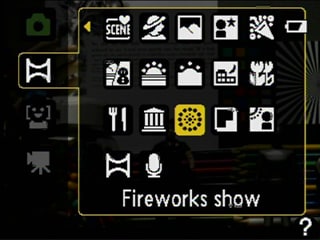
The tab of scene modes
There aren't many interesting shooting modes on the S630. There's a panorama assist, which overlays the previous image on-screen to help line up consecutive shots, but can't stitch together photos in-camera. Smile detector only shoots when it sees a grin. Sport continuous lowers the resolution, but can take up to 11 frames per second. High ISO boosts the ISO to a maximum of 3200, but at 3-megapixel resolution.
There is no separate Easy or completely automatic mode.
Picture Effects*(1.50)*
Picture effects are called Color Options by Nikon. There's Standard color and Vivid color, which are discussed in greater detail in the Color section of this review. There's also Black and White, Sepia, Cyanotype and Pastel.
Focus*(3.50)*
The autofocus system can be set to face priority, auto, center and manual. 'Manual' doesn't mean manual focus in the traditional sense, though; it lets you move the autofocus reticule around the LCD using the four-way pad.
In bright light, the focus was plenty quick, but the S630 has a lot of trouble focusing in dark situations. The autofocus assist lamp does little to help in poor illumination, and the camera failed to properly focus more often than not.
The focusing motor is quite loud, and makes a vaguely disconcerting grinding noise when trying to find the focus point.
Exposure*(2.00)*
The exposure compensation range is ±2EV in 1/3 step increments. There is no bracketing capability.
Metering*(6.00)*
Metering can be set to matrix (evaluative) or center-weighted. While using the latter, the region of the frame used for metering is marked on the LCD, a useful feature.
White Balance*(4.00)*
In addition to the automatic white balance system there are white balance presets for daylight, incandescent, fluorescent, cloudy and flash. You can also take a manual white balance reading, a capability often lacking in point and shoot cameras.
Aperture*(5.00)*
The aperture range is on the pedestrian side. It runs f/3.5-f/10 at wide angle, and f/5.3-f/14 at telephoto. This isn't fantastically fast, but it's acceptable for a camera in this class.
Shutter Speed*(5.50)*
During the course of normal photography, the maximum shutter speed is two seconds, and the minimum is 1/1500 of a second. In Fireworks mode, the maximum is boosted to four seconds, and in reduced resolution Sport Continuous mode, the minimum is shifted to 1/4000 second.
In face detection mode, there's an additional smile detection setting, which will automatically take a photograph when it notices a grin. This can also be paired with blink detection, which will take a second photo directly after the first, if the camera thinks the subject had closed eyes.
Self-Timer*(4.00)*
In addition to the usual 2 and 10 second timers, the Nikon S630 also has an interval timer shooting setting. This can be set to take photos every 30 seconds, 1, 5 or 10 minutes.
Drive/Burst Mode*(7.00)*
There are a number of continuous shutter modes on the S630. There's the standard Continuous, Best Shot Selector and Multi-shot 16. Continuous keeps taking photographs as long as the shutter is held down, though at a rather slow pace. Best shot selector takes 10 images in quick succession, and saves the one it thinks is the sharpest. Multi-shot 16 takes 16 images in seven seconds, and combines them all in a grid on a single image.
Shot to Shot (0.39)
In continuous mode, at the highest image quality setting, the S630 managed a sluggish 0.4 frames per second. The first two shots were fired much faster, but after that it slowed down considerably.
Design & Handling
Handling*(8.00)*
The Nikon Coolpix S630 is a very pleasant camera to handle. The distinctive 'swoosh' shape gives it a large and comfortable grip. It's well balanced and fits in the hand with grace and ease. It also has a nice little dimple for resting your thumb in when shooting, which is a pleasant concession to ergonomics. We do have some minor complaints though. The highly reflective body is easily smudged, and I/O port and battery covers both feel low quality.
The S630 is available in Jet Black, Titanium Silver, Ruby Red (which we reviewed), Midnight Blue, and Royal Purple.
Buttons & Dials*(8.50)*
One of the touches on the S630 that we really love is the combined four-way controller / rotary dial. You can still push up, down, left and right, but you can also turn the dial, which makes scrolling through pages and pages of options far quicker than repeatedly button-pressing. The buttons are all well spaced, labeled and have pleasant tactility. The one oddity of the control scheme, that will jump out at most point-and-shoot users, is that the OK button at the center of the dial doesn't do anything while shooting. On most cameras, this will bring up a quick menu, but not on this model.
Menu*(7.00)*
The S630 menu system is impressive, clearly laid out, with nice large text and a logical arrangement. While usually we dislike having to scroll through multiple pages of options to get to the ones we need, the scroll wheel on the S630 makes this task much easier. If you're not particularly text-inclined, there's also an option to switch the menu over to one entirely based around icons.
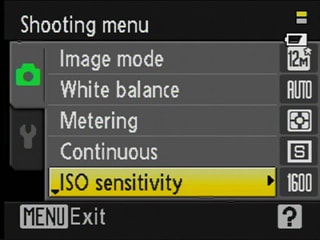
The menu system is well laid out
Manual & Learning*(7.00)*
The Nikon S630's manual is a bit of a pleasure in comparison to some of the horrendous documentation we receive with compact cameras. It's clearly written, covers features exhaustively, has excellent diagrams, and a good table of contents and index. You can download the manual from Nikon's website, here.
The manual is a bit on the intimidating side, clocking in at around 160 pages. There's also a simple Quick Start guide for users who just want to figure out how to turn on the camera and take a photo.
Canon SD780 Comp
The Nikon Coolpix S630 and Canon PowerShot SD780 are cameras that are very similar in purpose, but different in execution. They have an all but identical price, and are both straightforward point-and-shoots, that don't have much in the way of manual controls, but rather are designed for simple, pick-up-and-use mentality. The Canon does this in a much smaller frame, as the SD780 is a petite sliver of a camera. On the other hand, the Nikon S630 is substantially bigger, but also has a rather impressive 7x zoom lens versus 3x for the Canon.
In terms of performance, the Nikon scored higher in most still image tests, but the Canon has the edge in video mode. The Canon scored slightly better for resolution due to higher image sharpness, but it had worse distortion. The image stabilization system was slightly more effective on the Canon, as was the shot to shot speed. Its real advantage was in video mode, where the high definition capabilities blew the Nikon out of the water, and the S630's lack of manual white balance controls led to very poor video color. However for pure still image quality, we lean toward the Nikon.
Panasonic FX580 Comp
The Panasonic Lumix DMC-FX580 is a very different beast to the Nikon S630. It costs a fair amount more, with a touch-screen in addition to traditional button-based interface. It also has a full suite of manual controls, and the ability to shoot in aperture-priority, shutter-priority and full manual exposure modes, which we appreciate, and the S630 lacks.
The touch-screen system of the FX580 is well implemented in that it complements the button controls nicely. The only time you need to use it is for exposure compensation, or shifting aperture and shutter speed. The majority of controls are handled using the buttons, but with the additional capabilities of the touch-screen complementing these, rather than replacing them.
In terms of image quality, however, the Nikon substantially outperformed the Panasonic. In every test we ran that didn't involve video footage, the S630 handled better. The images were sharper, the colors more accurate, and the image noise lower. However, once again the Nikon's low resolution and lack of controls in video mode hit it hard, leaving it far behind the Panasonic.
The Nikon Coolpix S630 may take better pictures, but if you crave manual controls, then the Panasonic FX580 has a very strong appeal.
Sony T900 Comparison
The Sony Cyber-shot T900 and Nikon S630 are both easy to use point-and-shoots, with an emphasis on simplicity rather than a high degree of control. Of course the Sony costs $100 more, but that extra money gets you a much slimmer body, a 921,000-dot touch-screen, and a stylish look. It also gets you a fraction of the zoom, and a frustrating touch-based interface, with even fewer controls than the Nikon.
In terms of performance, the Sony has a noticeable advantage in a few places. Its color was a touch more accurate, it had sharper images, a much better stabilization system, faster burst rates, and higher-quality videos. In the Nikon's favor are significantly lower noise levels and much lower distortion.
While the Sony did perform better, it is still hampered by an overall poor user interface, primarily because of its inaccurate, unresponsive touch-screen and a high price. On the other hand, it gets style points for its sleek look and high-resolution screen.
Conclusion
Meet the tester
Tim Barribeau is a valued contributor to the Reviewed.com family of sites.
Checking our work.
Our team is here to help you buy the best stuff and love what you own. Our writers, editors, and experts obsess over the products we cover to make sure you're confident and satisfied. Have a different opinion about something we recommend? Email us and we'll compare notes.
Shoot us an email